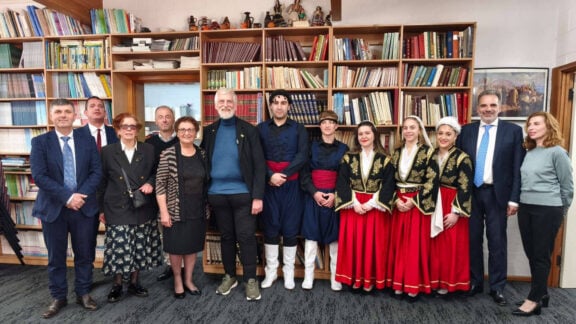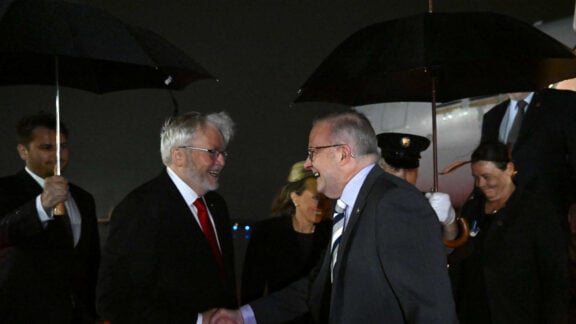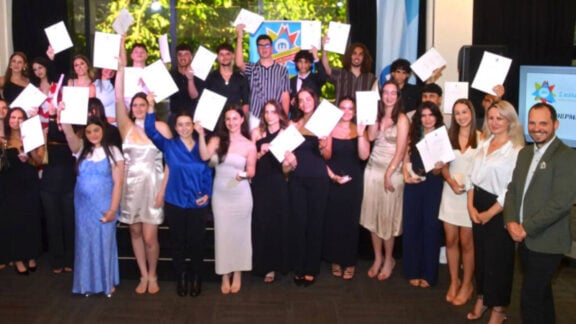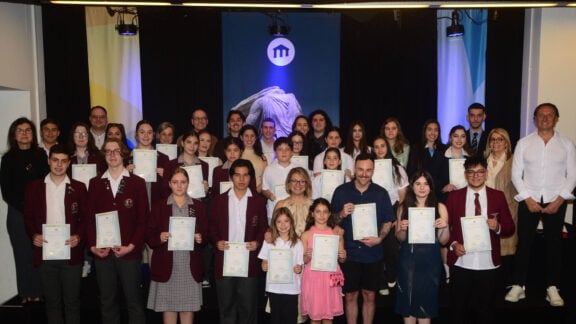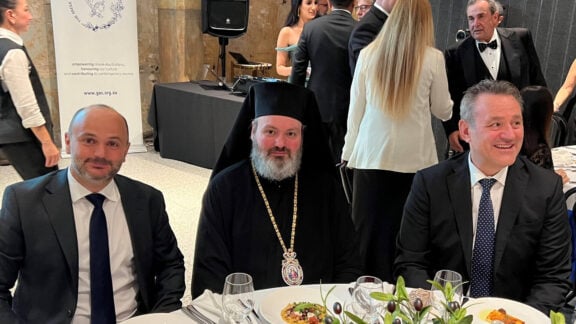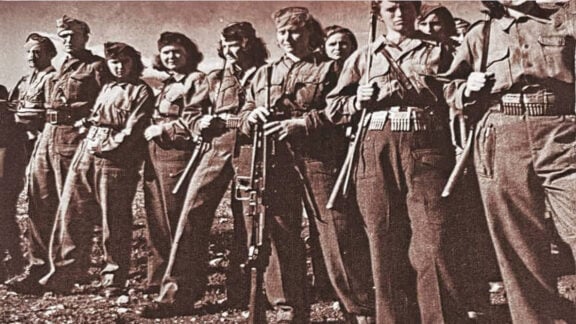A bright, colourful and complex mural adorning the street facade of the Imvrians’ Society of Melbourne greeted the more than 50 people who came to the re-opening of the building on Balcomebe Road in Mentone on Sunday after a long COVID-induced break.
Attending the opening, was the Mayor of Kingston, Councillor Steve Staicos, whose council contributed funds towards the the mural by artist Efrossini Chaniotis.
“The $3,000 grant to the community was an opportunity to tell the story [of] Anzac and Imvros – most people only know the connection with Lemnos,” Cr Staicos told Neos Kosmos.
Imvros was the forward base for Anzac forces on the Gallipoli campaign. Aussie bakers were based on the island to supply the bread for the soldiers fighting on the Gallipoli Peninsula. There was an airfield and a hospital also situated on the island.
But the mural incorporates not only the story of the link between the island and Anzac but many other aspects of the life and history of Imvros island.

Ms Chaniotis said there were at least five other Imvrian themes reflected in the mural that are historical, mythological and cultural. For example, it was 57 years ago, on 15 March 1965, that Imvrian-born Archbishop Iakovos of the Greek Orthodox Archdiocese of North and South America accompanied Martin Luther King to the Dallas County Courthouse in Selma, Alabama, one of few white leaders to have taken part in a defining moment of US civil rights history. The event made the cover of Life magazine and is commemorated on Ms Chaniotis’ mural.
“Imvros has so much history, it was important to reflect it on an outdoor mural – it was a strong opportunity to present the story to the world,” said Ms Chaniotis.
The island was important to Poseidon, according to Homer’s Iliad, he kept the stable of his winged horses between Imvros and Tenedos. An image of the sea god dominates the entrance to the building.
The island’s links to Athens are commemorated with a rendition of the ancient Athenian coins that were found on the island.
She said the mural also included references to the panigyri and its importance to the celebration of music and culture in the life of the island. The importance of the folk tale, paramythia, is also represented as is the islands unique natural environment and its cuisine.

Cards featuring the mural are on sale as part of a fund-raising drive. Photo: Supplied.

The Mayor of Kingston City Council, Steve Staicos, left, cuts the vasilopita with Arthur Pinirou, the president of the Imvrians' Society of Melbourne looking on during the reopening of the society's building in Mentone last Sunday. Photo: Supplied.

Detail shows some of the island's flora and fauna. Photo: Supplied
“The mural was my genuine response to learning about the community and listening to them and finding out how they want to be portrayed. It is aimed at generating curiosity from the wider community and many conversations may follow from that,” said Ms Chaniotis.
Committee member George Xinos said the mural covered what was an “ageing blank white wall”.
“Everyone stops to ask about the mural, it is a talking point for visitors, so it connects to the broader community ” Mr Xinos told Neos Kosmos. “We want to make connections with the local Returned and Servicemen’s League (RSLs) and with local schools over the island’s ANZAC connection.”
He said one digger took oat seeds from the island home with him which he found did very well in Victorian conditions.
He said there were plans to place QR codes that would provide links to recorded stories to the various images on the mural.
The building will be open for weekly social gatherings on Sunday afternoons and Mr Xinos said there were also plans to hold a photograph exhibition curated by historian and Neos Kosmos contributor Jim Claven which would reflect on the link between Imvros and the Anzac Campaign.
He said that Professor Anastasios Tamis would give a talk on his recent book Imvros and Tenedos which looked at the history of the island from 1912 to 1923, when they were under Greek control and then fell under the control of the Turkish Republic as a result of the Treaty of Lausanne, to the mass exodus of the overwhelmingly Greek population beginning in the 1960s as Turkish attitudes hardened in the wake of events in Cyprus.

The building before the mural went up. Photo: Supplied

The building with the mural completed by artist Efrosinni Chaniotis. Photo: Supplied

Detail from the mural reflects the ANZAC connection to the island and the face of grieving mother. Photo: Supplied.

Poseidon dominates the entrance to the building in Mentone. Photo:Supplied
Mr Xinos said that the island which was Turkey’s largest was being transformed by tourism with regular links from the mainland to the island.
“In 2015, a Greek-speaking school from junior to high-school level, opened on the island. Some Greek families have been able to reclaim and renovate their homes and the Greek/Rumei community has grown to 500 people.
“The big celebrations, such as 15 August, and other cultural events do take place on the island. Greek Orthodox Patriarch Bartholomew I of Constantinople is from Imvros and is active in keeping the community alive,” said Mr Xinos.
As for the community in Melbourne, he said the membership pre-COVID had been around 150 members and he expected the numbers to rise again once the community’s centre became more active. “Over the past five years, the majority of the committee is made up of second-generation members. We are hoping to focus on the ANZAC component so that the third and fourth-generation can learn of the links of their forefathers with Australia.”
“We are also making links with other associations from the region of the northern Aegean, and Asia Minor,” he said.

